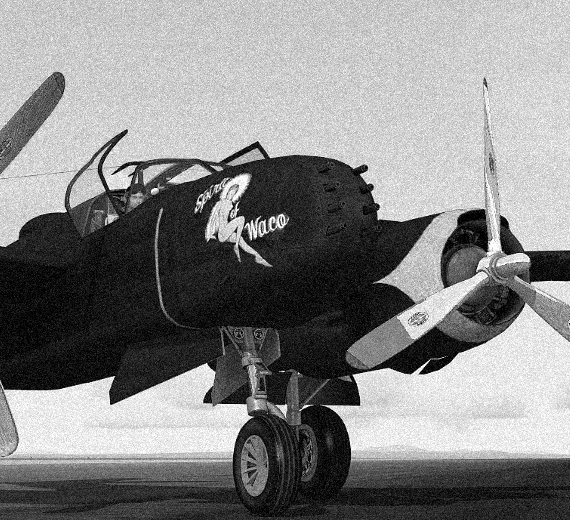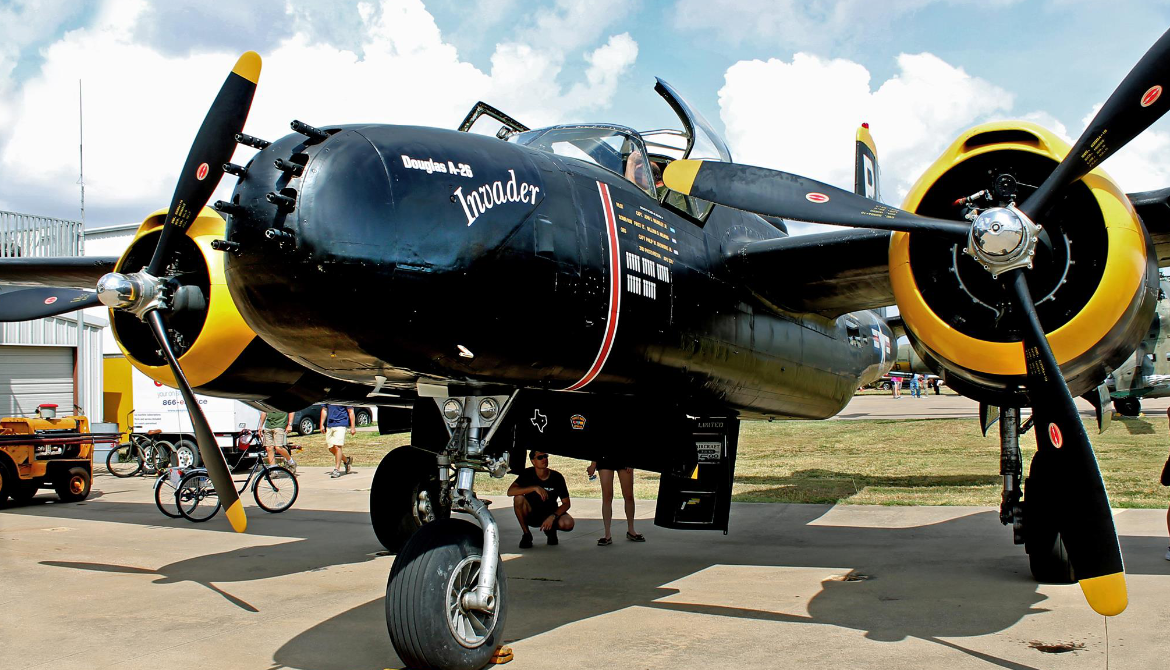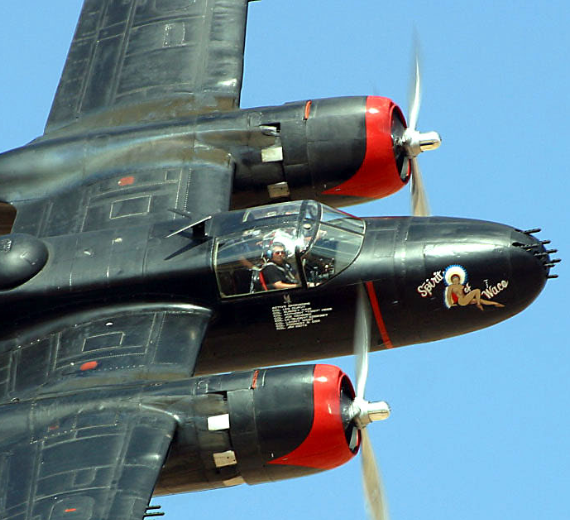Douglas
A-26/B-26 Invader
Role Ground attack
Light bomber
Manufacturer Douglas Aircraft Company
First flight 10 July 1942
Retired 1980 Colombian Air Force
Primary users United States Army Air ForcesUnited States Air Force United States Navy
French Air Force
Number built 2,503
Variants On Mark Executive, Marketeer, and Marksman
.
History
Douglas A-26/B-26 Invader "Spirit of Waco"

The Douglas A-26 Invader (designated B-26 between 1948 and 1965) is an American twin-engined light bomber and ground attack aircraft. Built by Douglas Aircraft Company during World War II, the Invader also saw service during several major Cold War conflicts. A limited number of highly modified United States Air Force aircraft served in Southeast Asia until 1969. It was a fast aircraft capable of carrying a large bomb load. A range of guns could be fitted to produce a formidable ground-attack aircraft
The A-26 was Douglas Aircraft's successor to the A-20 (DB-7) Havoc, also known as Douglas Boston.
Designed by Ed Heinemann, Robert Donovan, and Ted R. Smith, the innovative NACA 65-215 laminar-flow airfoil wing of the A-26 was the work of project aerodynamicist A.M.O. Smith. The Douglas XA-26 prototype (AAC Ser. No. 41-19504) first flew on 10 July 1942 at Mines Field, El Segundo, with test pilot Benny Howard at the controls. Flight tests revealed excellent performance and handling, but engine-cooling problems led to cowling changes and elimination of the propeller spinners on production aircraft. During testing, the nose wheel was found to be structurally inadequate, thus the nose gear was redesigned and made more structurally sound
After about 1,570 production aircraft, three guns were installed in each wing, coinciding with the introduction of the "eight-gun nose" for A-26Bs, giving some configurations as many as 14 .50 in (12.7 mm) machine guns in fixed forward mounts. An A-26C nose section could be replaced with an A-26B nose section, or vice versa, in a few hours, thus physically (and officially) changing the designation and operational role. The "flat-topped" canopy was changed in late 1944 after about 820 production aircraft, to a clamshell style with greatly improved visibility. Alongside the pilot in an A-26B, a crew member served as navigator and gun loader for the pilot-operated nose guns. In an A-26C, that crew member served as navigator and bombardier , and relocated to the nose section for the bombing phase of an operation. A few A-26Cs were fitted with dual flight controls, some parts of which could be disabled in flight for access to the nose section. Access for the bombardier was through the lower section of the right instrument panel; he normally sat next to the pilot. This was similar to British designs such as the Lancaster , Blenheim / Beaufort , Wellington , etc. A tractor-style "jump seat" was behind the "navigator's seat"
0
KmCeiling
0
KmCombat RANGE
0
Km/hAircraft Speed
0
Max Crew
Photo Gallery
Douglas A-26 Invader "Spirit of Waco"


Douglas A-26 Invader
General Info
-
-
- Crew: 3
- Length: 50 ft (15 m)
- Wingspan: 70 ft (21 m)
- Height: 18 ft 6 in (5.64 m)
- Wing area: 540 sq ft (50 m2)
-
Powerplant
-
-
- Empty weight: 22,370 lb (10,147 kg)
- Gross weight: 27,600 lb (12,519 kg)
- Max takeoff weight: 35,000 lb (15,876 kg)
- Fuel capacity: 925 US gal (770 imp gal; 3,500 L) normal + optional 675 US gal (562 imp gal; 2,560 L) ferry tank in the bomb bay; Oil capacity 60 US gal (50 imp gal; 230 L) in two nacelle tanks
- Powerplant: 2 × Pratt & Whitney R-2800-71 Double Wasp or -27s, or -79s 18-cylinder air-cooled two-row radial piston engines, 2,000 hp (1,500 kW) each for take-off
- Propellers: 3-bladed Hamilton Standard Hydromatic, 12 ft 7 in (3.84 m) diameter constant-speed fully-feathering propellers
-
Performance
- Maximum speed: 359 mph (578 km/h, 312 kn) at 16,700 ft (5,100 m) (normal rated power)
- Cruise speed: 266 mph (428 km/h, 231 kn) at 5,000 ft (1,500 m) (62.5% rated power)
- Range: 1,600 mi (2,600 km, 1,400 nmi) without ferry tank at 5,000 ft (1,500 m) at 206 mph (179 kn; 332 km/h)
- Service ceiling: 28,500 ft (8,700 m) ; 14,400 ft (4,400 m) on one engine
- Time to altitude: 10,000 ft (3,000 m) in 8 minutes 6 seconds
Armament
-
-
Guns:
- 6 or 8 0.50 in (12.7 mm) M2 Browning machine guns in solid, "all purpose" nose: or 2 0.50 in (12.7 mm) M2 machine guns in glass "bombardier" nose
- Up to 8 0.50 in (12.7 mm) M2 machine guns paired in four optional under wing pods: or 3 0.50 in (12.7 mm) M2 machine guns in each outer wing panel
- Rockets: Up to 10 5-inch (12.7 cm) HVAR rockets on "zero length" launch pylons, five under each outer wing panel
- Bombs: Up to 6,000 lb (2,700 kg) capacity - 4,000 lb (1,800 kg)
-
-
-
Guns:
.
Links to Youtube & Others
The MB-339 was developed during the 1970s in response to an Italian Air Force requirement that sought a replacement for the service's existing fleet of Aermacchi MB-326s.
Douglas A-26 Invader
The Invader Squadron was formed to restore the Douglas A-26B Invader 43-7140 as an 8th Bomb Squadron
Youtube Link
This is the A-26 Night Mission / Spirit of Waco at the 2016 Wings Over Dallas airshow.












